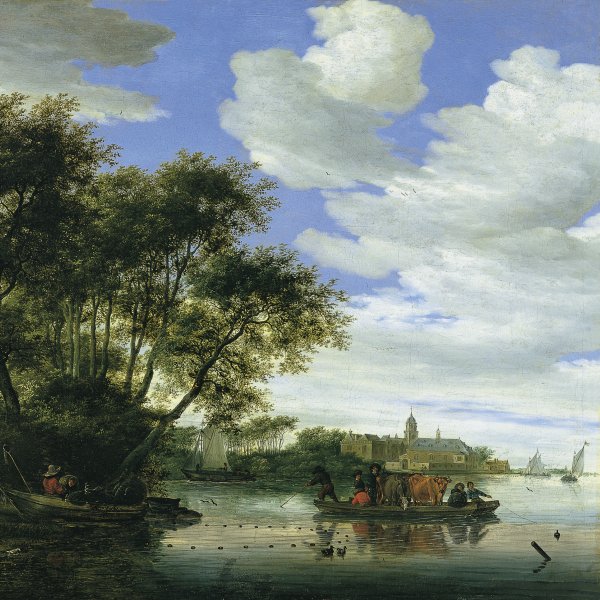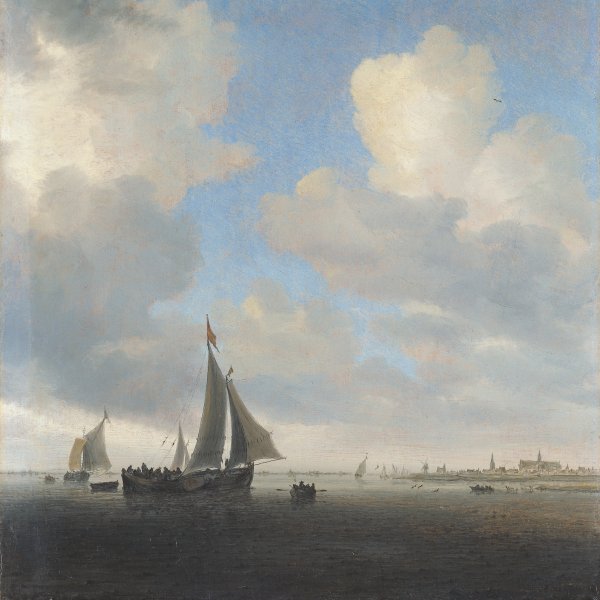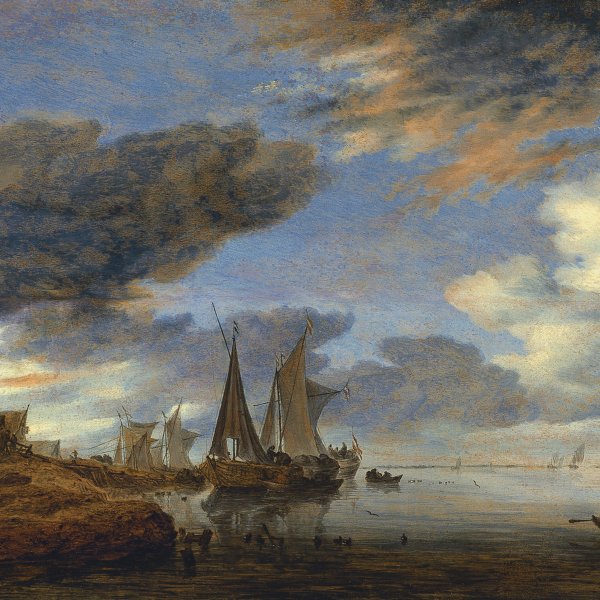A River Landscape with Figures and a Wagon on a Jetty with Sailing Boats
ca. 1660 - 1670
Oil on panel.
26 x 49 cm
Carmen Thyssen Collection
Inv. no. (
CTB.1999.38
)
ROOM A
Level 0
Carmen Thyssen Collection and Temporary exhibition rooms
On a wooden jetty on the right bank of a river with low vegetation, a horse-drawn wagon appears silhouetted above several boats. A man climbs a set of steps to the top on the jetty on the far right. Below figures appear in a rowboat. Farther to the left and immediately below the wagon, figures busy themselves raising the sails of a boat viewed broadside. The vessel and jetty partly obscure two other sailboats, the sails, masts and flag of which rise into the sky. Two smaller rowboats and several ducks ply the waters in the centre left. The darkened form of another crowded boat with one figure standing rows off into the rippling current. On the horizon are three vessels under full sail, and in the distance the thin band of the far shore is punctuated by the form of a church and other buildings.
The uncle of the famous landscapist, Jacob van Ruisdael (c. 1628/29-1682), and the father of Jacob Salomonsz. van Ruysdael (c. 1629/30-1681), who also was active in Haarlem as a painter, Salomon was one of the most accomplished and innovative Dutch landscapists of the 17th century. Although he painted winter scenes, dunescapes, woodland views and even a few dead bird still-life paintings, his favourite subject was views of calm rivers and estuaries. He began painting river scenes in the mid 1620s in the style of Esaias van de Velde, who is assumed to have been his teacher, and by 1631 he had developed a new approach to the subject. Employing diagonals designs, atmospheric effects and a restrained palette of earth hues (grey-green, brown and umber), Salomon together with Jan van Goyen invented the "tonal" river landscape, which to this day is regarded as one of the archetypal Dutch landscape themes. Throughout the remainder of his career he painted subtle variations on this schema, filling the foreground with water, varying the motifs in the diagonally retreating bank and among the silhouetted boats, making the theme uniquely his own. Salomon's views of rivers, canals and estuaries not only eloquently evoke the complex system of inland waterways that were the commercial life blood as well as the circulatory system for transport and communication in the watery little Republic of the Netherlands, but also capture a special feature of the beauty of Holland.
In Salomon's mature works from the late 1640s and 50s he introduced stronger contrasts of tonal value and colour accents, and placed a greater emphasis on structure and varied meteorological effects. Stechow correctly dated the present work to the last decade of the master's career, the 1660s, when his touch became still more painterly, especially in the treatment of the rippling water and rustling foliage, and he took special pleasure in the local application of colour; note the bright blue passages of the sky and the red of the figure's coat in the rowboat on the right. The authors of the Thomas Mellon Evans Collection sale catalogue likened the painting's design and conception to those of two other dated river landscapes by Salomon, of 1665 and 1666. However aspects of the present work's composition, including the jetty made of stout wooden planks on the right bank, the broad and darkener expanse of water in the foreground, and the configuration of the silhouetted boats are anticipated in a painting dated 1651, formerly in the Milligan Collection, Caldwell Hall, Burton-on-Trent. Stechow noted that a copy of the present work or possibly the same painting, but with a higher sky (now presumably cut) and details like the fishing boat on the right overpainted, was in the C. Pagenstecher Sale, Cologne, with the dimensions 40 x 50 cm. If identical, it would suggest that the present work originally resembled the painting with the soaring sky dated 1651 more closely.
Peter C. Sutton
The uncle of the famous landscapist, Jacob van Ruisdael (c. 1628/29-1682), and the father of Jacob Salomonsz. van Ruysdael (c. 1629/30-1681), who also was active in Haarlem as a painter, Salomon was one of the most accomplished and innovative Dutch landscapists of the 17th century. Although he painted winter scenes, dunescapes, woodland views and even a few dead bird still-life paintings, his favourite subject was views of calm rivers and estuaries. He began painting river scenes in the mid 1620s in the style of Esaias van de Velde, who is assumed to have been his teacher, and by 1631 he had developed a new approach to the subject. Employing diagonals designs, atmospheric effects and a restrained palette of earth hues (grey-green, brown and umber), Salomon together with Jan van Goyen invented the "tonal" river landscape, which to this day is regarded as one of the archetypal Dutch landscape themes. Throughout the remainder of his career he painted subtle variations on this schema, filling the foreground with water, varying the motifs in the diagonally retreating bank and among the silhouetted boats, making the theme uniquely his own. Salomon's views of rivers, canals and estuaries not only eloquently evoke the complex system of inland waterways that were the commercial life blood as well as the circulatory system for transport and communication in the watery little Republic of the Netherlands, but also capture a special feature of the beauty of Holland.
In Salomon's mature works from the late 1640s and 50s he introduced stronger contrasts of tonal value and colour accents, and placed a greater emphasis on structure and varied meteorological effects. Stechow correctly dated the present work to the last decade of the master's career, the 1660s, when his touch became still more painterly, especially in the treatment of the rippling water and rustling foliage, and he took special pleasure in the local application of colour; note the bright blue passages of the sky and the red of the figure's coat in the rowboat on the right. The authors of the Thomas Mellon Evans Collection sale catalogue likened the painting's design and conception to those of two other dated river landscapes by Salomon, of 1665 and 1666. However aspects of the present work's composition, including the jetty made of stout wooden planks on the right bank, the broad and darkener expanse of water in the foreground, and the configuration of the silhouetted boats are anticipated in a painting dated 1651, formerly in the Milligan Collection, Caldwell Hall, Burton-on-Trent. Stechow noted that a copy of the present work or possibly the same painting, but with a higher sky (now presumably cut) and details like the fishing boat on the right overpainted, was in the C. Pagenstecher Sale, Cologne, with the dimensions 40 x 50 cm. If identical, it would suggest that the present work originally resembled the painting with the soaring sky dated 1651 more closely.
Peter C. Sutton









